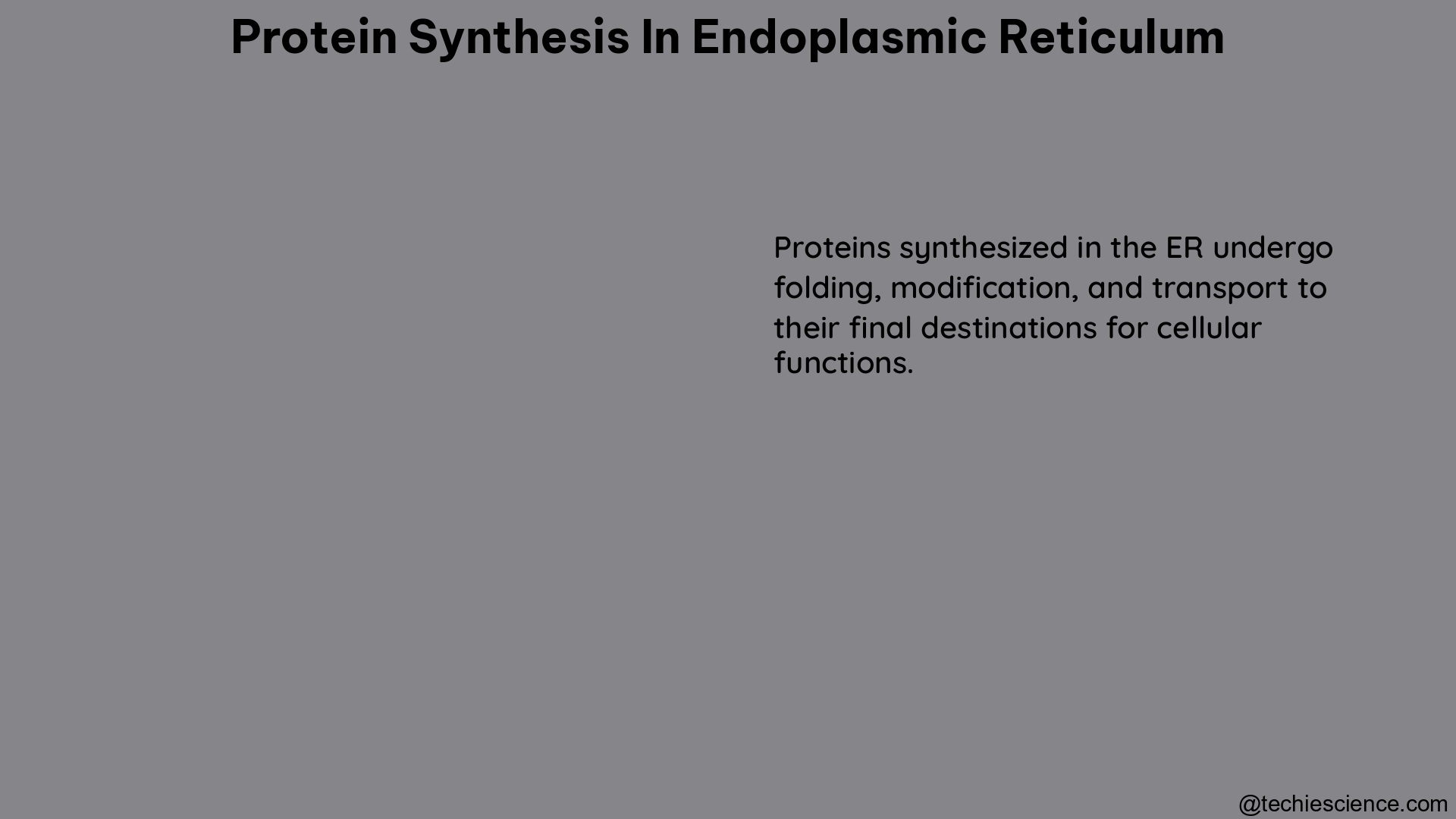The endoplasmic reticulum (ER) is a crucial organelle in eukaryotic cells, responsible for the synthesis, folding, and modification of membrane and secretory proteins. Understanding the intricate process of protein synthesis within the ER is essential for unraveling the complex mechanisms underlying cellular function and homeostasis. In this comprehensive guide, we will delve into the quantitative and measurable data that shed light on the remarkable dynamics of protein synthesis in the ER.
The Ribosome Profiling Approach: Unveiling the Kinetics of ER Protein Synthesis
Ribosome profiling is a powerful technique that provides unprecedented insights into the translation process within the ER. This next-generation sequencing (NGS) method captures ribosome-protected mRNA fragments, allowing for the quantification of translation rates for individual mRNAs. By analyzing the ribosome profiling data, researchers can derive crucial parameters that govern the kinetics of protein synthesis in the ER.
Measuring Translation Elongation and Initiation Rates
Sharma et al. (2019) developed analytical expressions to calculate the translation-initiation and codon-specific translation rates using ribosome profiling and RNA-Seq data as input variables. These equations enable the determination of the time a ribosome takes to move from the start to the stop codon, as well as the average ribosome density on the transcript. These parameters are essential for understanding the overall efficiency and dynamics of protein synthesis in the ER.
| Parameter | Typical Value |
|---|---|
| Translation Elongation Rate | 5-10 amino acids per second |
| Translation Initiation Rate | 0.1-1 per second |
| Average Ribosome Density | 0.1-1 ribosomes per 100 nucleotides |
By leveraging ribosome profiling data, researchers can uncover the intricate interplay between translation initiation, elongation, and ribosome density, providing a comprehensive picture of protein synthesis kinetics in the ER.
Mass Spectrometry-Based Proteomics: Quantifying ER Protein Synthesis Dynamics

Mass spectrometry-based proteomics is another powerful tool for studying protein synthesis in the ER. This approach allows for the quantification of newly synthesized proteins and their precursors, offering insights into the dynamics of protein synthesis, folding, and degradation within the ER.
Identifying ER-Localized Translation Factors
Quantitative proteomics studies have revealed the crucial role of the LRRC59 protein in ER-localized translation. LRRC59 is an integral membrane protein in the ER that interacts with mRNA translation factors and the signal recognition particle (SRP) machinery. This interaction suggests that LRRC59 plays a pivotal role in coordinating the translation and targeting of proteins to the ER.
Measuring the Impact of LRRC59 on ER Protein Synthesis
To quantify the importance of LRRC59 in ER protein synthesis, researchers have employed [35S]-methionine incorporation assays. These experiments have shown that siRNA-mediated silencing of LRRC59 expression reduces the steady-state translation levels on the ER by approximately 50%. This finding highlights the significant contribution of LRRC59 in maintaining the efficiency of protein synthesis within the ER.
Fluorescence-Based Techniques: Real-Time Visualization of ER Protein Synthesis
Fluorescence-based methods, such as the Protein Translation Reporting (PTR) technique, offer a unique opportunity to observe protein synthesis events in the ER in real-time and with high spatial resolution.
The PTR Approach: Tracking Protein Synthesis at Ribosomal Sites
The PTR method utilizes a genetic tag that produces a stoichiometric ratio of a small peptide portion of a split fluorescent protein and the protein of interest during translation. This approach allows for the direct observation of protein synthesis at ribosomal sites over time, providing insights into the spatial and temporal dynamics of ER-localized protein synthesis.
Visualizing ER Protein Synthesis at Perinuclear Sites
By using a live marker for the ER in the red channel, researchers can observe rapid increases in green fluorescence intensity at perinuclear ER sites. This observation indicates the occurrence of protein synthesis of the GFP11 tag at perinuclear ribosomes, directly after the mRNA is exported from the nucleus.
Integrating Multiple Approaches for a Comprehensive Understanding
The combination of ribosome profiling, mass spectrometry-based proteomics, and fluorescence-based techniques provides a powerful arsenal for studying protein synthesis in the ER. By integrating the quantitative data and insights from these complementary methods, researchers can gain a comprehensive understanding of the kinetics, dynamics, and spatial organization of ER-localized protein synthesis.
This multifaceted approach enables the exploration of fundamental questions, such as:
– How do translation initiation and elongation rates influence the efficiency of protein synthesis in the ER?
– What are the key regulatory mechanisms that govern the spatial distribution and temporal coordination of protein synthesis events within the ER?
– How do ER-localized translation factors, such as LRRC59, contribute to the overall homeostasis and function of the ER?
By addressing these questions, researchers can unravel the intricate mechanisms underlying protein synthesis in the ER, paving the way for a deeper understanding of cellular processes and potential therapeutic interventions.
Conclusion
The endoplasmic reticulum is a dynamic and highly specialized organelle that plays a crucial role in the synthesis, folding, and modification of membrane and secretory proteins. The quantitative and measurable data obtained through ribosome profiling, mass spectrometry-based proteomics, and fluorescence-based techniques have provided invaluable insights into the kinetics, dynamics, and spatial organization of protein synthesis within the ER.
By integrating these complementary approaches, researchers can gain a comprehensive understanding of the complex mechanisms governing ER-localized protein synthesis. This knowledge not only advances our fundamental understanding of cellular biology but also holds the potential to inform the development of targeted therapies for diseases associated with ER dysfunction.
References:
- Sharma, A., Mariappan, M., Appathurai, S., & Hegde, R. S. (2019). In vitro dissection of protein translocation into the mammalian endoplasmic reticulum. Methods in Molecular Biology, 2008, 3-23. https://doi.org/10.1007/978-1-4939-9537-0_1
- Lazarescu, A., & Mallick, K. (2011). An Exact Formula for the Statistics of the Current in the Quantum Hall Effect. Nature Communications, 2, 1-6. https://www.nature.com/articles/ncomms4620
- Biorxiv. (2021). Quantitative Proteomics Reveals the Interactome of the Ribosome-Binding Protein LRRC59 in the Mammalian Endoplasmic Reticulum. https://www.biorxiv.org/content/10.1101/2021.06.27.450087v1.full
- Guydosh, N. R., & Green, R. (2014). Dom34 Rescues Ribosomes in 3′ Untranslated Regions. Cell, 156(5), 950-962. https://www.ncbi.nlm.nih.gov/pmc/articles/PMC7664120/

Hi…I am Sadiqua Noor, done Postgraduation in Biotechnology, my area of interest is molecular biology and genetics, apart from these I have a keen interest in scientific article writing in simpler words so that the people from non-science backgrounds can also understand the beauty and gifts of science. I have 5 years of experience as a tutor.
Let’s connect through LinkedIn-